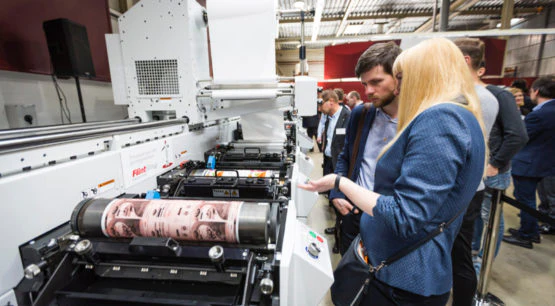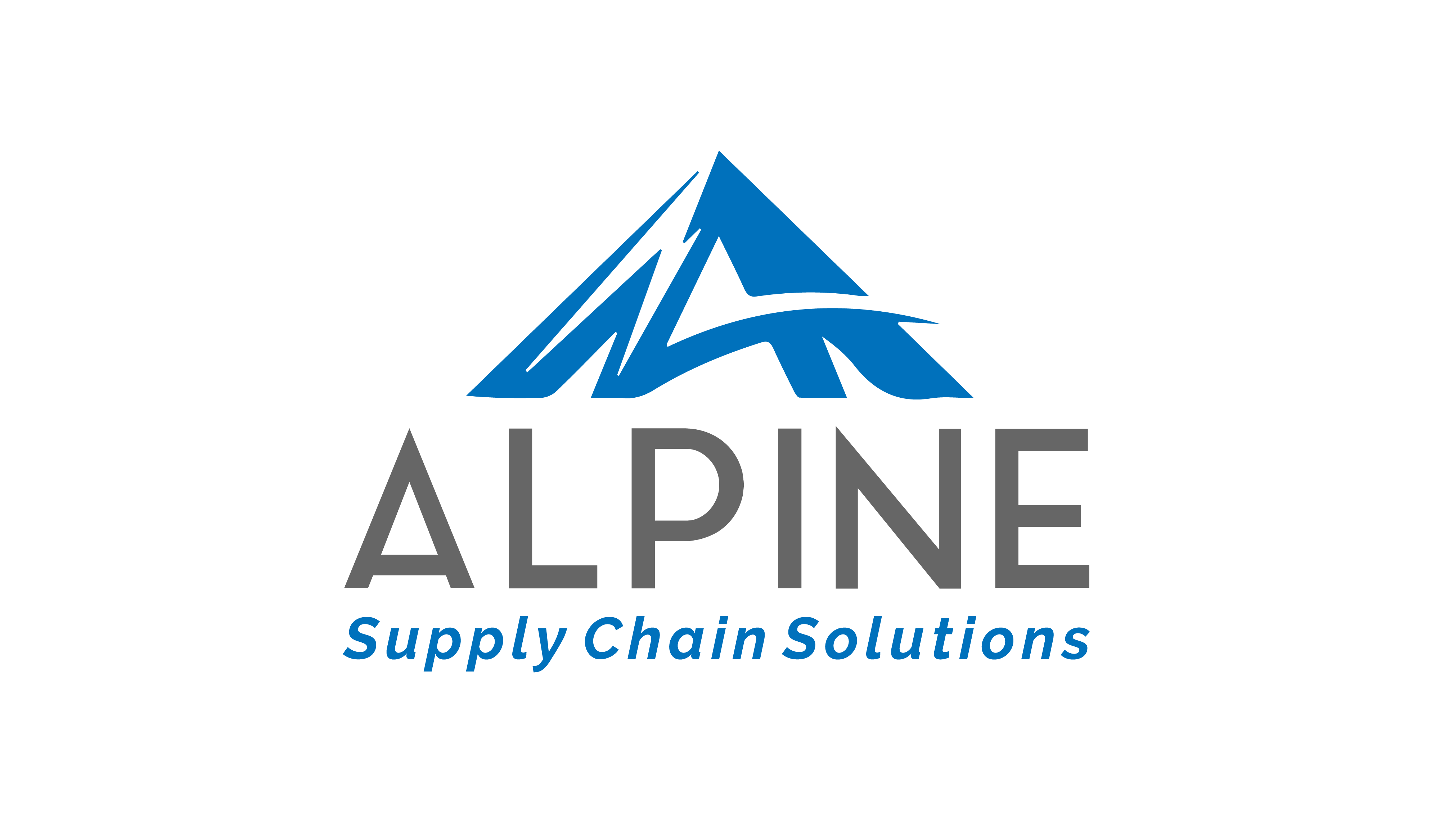
by Alpine Supply Chain | Dec 20, 2020 | 3PL
From SDC Executive: Alpine Optimizes Distribution for Mark Andy Print Products
Alpine Supply Chain Solutions completed a multi-faceted project that optimizes distribution for Mark Andy Print Products, a global manufacturer of printing presses. Alpine provided consulting services to improve space utilization, productivity, and replenishment cycle times at Mark Andy’s primary distribution center in Des Plaines, Ill., and conducted a network analysis to determine the best location for third-party logistics (3PL) facilities to facilitate next-day shipping for customers.
Mark Andy was outgrowing its 80,000-square-foot distribution center and needed to determine if 40,000 or 80,000 additional square feet was needed. Alpine conducted a storage type analysis, facility design and slotting project to create the right-sized product homes and place the right products into the best locations, maximizing space usage and improving productivity.
“Alpine has a well-rounded team that understands all aspects of supply chain operations as well as current industry standards,” said Stuart Gallup, Vice President-Commercial Market for Mark Andy. “They were able to rapidly respond to changing information in a very dynamic environment and provided the best solution at a given cost which increased our ROI.”
In addition to the warehouse optimization project, Mark Andy also recognized the need for new locations across the United States to facilitate next-day delivery. Alpine conducted a network analysis to understand where Mark Andy customers were located and to determine the ideal number of facilities and inventory levels required to provide their network with a 98% next-day service window. Alpine then conducted an in-depth RFP process and helped Mark Andy select and onboard five new 3PL locations in five months.

by Alpine Supply Chain | Dec 20, 2020 | Strategic Planning, Supply Chain News, Warehouse Consulting, Warehouse Slotting
School Health Corp., an Alpine Supply Chain Solutions client, was recently featured in Modern Materials Handling article discussing their new warehouse project using innovative labeling and strategic warehouse slotting optimization.
“While we are adept at warehouse operations and order fulfillment, our current team had never designed a warehouse from scratch before,” says Beth Reed, School Health’s project manager/training developer.
“With this in mind, how could the company slot its product inventory for maximum efficiency and throughput? What is the best way to handle seasonal spikes in demand for certain products, which typically occur at the start of each new school year? And, how should it number and label its bins—for optimal performance with its existing warehouse management software?”

Beth Reed, Project Manager & Training Developer at School Health
To receive assistance with its warehouse location methodology and slotting plans, School Health Corp worked with Alpine SupplyChain Solutions. The project’s goals included minimizing the time and distance required to replenish key products; reducing workers’ bend-and-reach requirements for placing and picking products; and organizing its inventory more efficiently, leading to greater throughput.
“In my role, I hadn’t previously spent a lot of time thinking about warehouse location address methodology,” Reed notes. “But working with Alpine made the entire project team appreciate the science involved in slotting our products.” She continues, “An optimally slotted warehouse supports efficiency and profitability. Just as important, it also minimizes the time and effort involved in key tasks like product putaway, picking and order fulfillment, which our employees appreciate.”

by Alpine Supply Chain | Nov 19, 2020 | Supply Chain Consulting, Warehouse Consulting News
Five questions with Bradley Steger, the newest member of Team Alpine
Q: Why did you decide to join the Team Alpine?
A: There are several reasons I joined Alpine. First off, I’ve known Alpine’s founder, Michael Wohlwend for a long time, and I admire his knowledge and leadership. Next, my background in the supply chain aligns well with what Alpine is doing. I look forward to helping Alpine’s customers and partners move their businesses forward. Finally, who doesn’t want to work in supply chain right now? It is an incredibly dynamic place to be and it will be for the foreseeable future!
Q: What were you doing before you joined Alpine?
A: I was semi-retired and focused on spending time with my family and getting caught on many things that had been second priority to my career. Prior to that, I spent 30 years working in supply chain management with a focus on warehouse management; software mergers, acquisitions, and divestitures; and program/project management.
Q: What professional accomplishments are you most proud of?
A: I’ve blazed a lot of unchartered territory. Throughout my career, I was frequently assigned to lead many ‘first-ever’ projects, including the production of Catalyst’s first annual plan, Agilent’s first Sarbanes Oxley certification, and Aptean’s first acquisition. I’m proud that I’ve been able produce results without a roadmap or template, and that I’ve always tried to take in account the most important thing for every company – its employees.
Q: Why do you do what you do?
I think there are a lot of exciting opportunities out there in the supply chain. An aging population means new things for the pharmaceutical industry and the ever-changing retail landscape presents new challenges for retailers and food and beverage manufacturers. I really enjoy making the people around me successful – fellow employees, customers, and partners.
Q: Tell us a bit about who you are outside of work.
I’m married and have two sons, ages 13 and 11. They keep us busy with their sports, including soccer, basketball, and volleyball. We try to spend as much time as possible at our vacation homes in Colorado and Northern Wisconsin. If I have any free time, I like to get outside for some birding.

by Alpine Supply Chain | Nov 15, 2020 | Uncategorized
I’ve just finished some market research on the system integration (SI) market for warehouse management systems (WMS). I talked to system integrators WMS practices. However, many of my takeaways would apply to SIs implementing other enterprise applications.
Here are 20 takeaways from that research.
1. In general, it will be less expensive to have SI’s implement a WMS then to use consultants from WMS suppliers. This is particularly true if the system integrator has a large number of consultants working in India or other lower priced regions and implementations involve a combination of onsite and offsite personnel.
2. In any engagement, having a good cultural fit between SI and client matters. For engagements conducted in the onshore/offshore model, cultural issues need to be more carefully managed.
3. SIs report that when COVID hit they had little problem doing a much higher percentage of the work remotely. They know that once the pandemic is over, more work will again be done on site. But some hope to continue to do a higher percentage of work remotely as a way of improving work/life balance for their employees. Turnover can be high among system integrators because so much time is spent on the road. Turnover is also high in India for several of the large global consulting firms.
4. For the most part, system integrators report that implementations of WMS in complex warehousing environments are not getting faster despite SaaS and cloud-based solutions. These implementations still generally take 9 months or more.
5. SI’s who work with Oracle’s ORCL +0.4% Cloud WMS are the exception. They report significantly faster implementations than for the other major WMS solutions in the market. Several SIs, however, say that while Oracle Cloud is a good solution for many warehouses, it would not be functionally rich enough for a complex distribution center.
6. Several WMS SIs have developed methodologies for faster implementations. Agile, rather than the traditional waterfall approach, is often key to this approach. The goal is to get clients to implement the WMS without customizing it. Workshops are held showing how a process can be completed using the out-of-the-box functionality. The consultant gets approval to explore the best practice in the WMS for that process. They then quickly configure that process, show it to the client within a few days, let the client play with it, and either get confirmation that the out-of-the box configuration will work or go back to the drawing board and see if configuring the system slightly differently will meet the client’s needs.
7. Alternatively, some SIs have a vendor selection offering. They gather requirements and then select the WMS solution that meets most of the requirements their client has asked for. This approach virtually assures customization.
8. While Agile does not always seem to result in significantly faster implementations in complex environments, it clearly does reduce customization. That improves the ROI of the WMS.
9. The productivity of a warehouse often falls for a period after the implementation as users struggle to get use to new ways of doing things. Many SIs have a hypercare program where their consultants remain on site during the transition and are available to give hands on help to workers in the warehouse trying to get use to new ways of doing things. Hypercare reduces improves time to value by shortening the amount of time the productivity of the warehouse is below what it had been.
10. More system integration work is done surrounding SAP’s SAP +0.6% Extended Warehouse Management (EWM) EWM -1% than any other WMS solution. SAP and Oracle’s preference is to have much of the work around implementations be done by consulting partners. Blue Yonder is transitioning to this philosophy.
11. When suppliers list Gold or Platinum partners, those lists do not necessarily reflect which SIs have done the most work implementing their solution. A higher level partnership can reflect a willingness of the SI to engage in joint marketing campaigns with the WMS vendor.
12. SIs give SAP high marks for their warehouse control system, called Warehouse Flow Control. This solution is used in highly automated warehouses. They also praise the functionality of EWM in terms of functionality for warehouses attached factories.
13. SAP also has a less functional WMS, known as WM, that is part of their ERP solution rather than a standalone solution like EWM. WM consultants often lack the requisite skills to implement EWM.
14. One practice that can lead to problem implementations is for a system integrator to subcontract out some of the work to another SI firm.
15. Boutique SIs make the point that when a company selects them, they know who will work on the project. Global SIs may send in a suave and polished consultant who will sell the project but then not participate, or barely participate, in the implementation.
16. The WMS SI is a highly fragmented marketplace with many, many SI firms and many different business models.
17. Some boutique consulting firms only implement solutions from one WMS supplier. They argue that this specialization makes them better partners. These firms often employ consultants that used to do product development or implementations for the WMS supplier.
18. Several SIs are also software companies. In implementing WMS, they have learned of functional gaps and built solutions that bolt-on to the WMS and improve its capabilities.
19. Never skimp on testing. Look for consultants that have developed testing tools and methodologies.
20. Look for consultants who have developed integration tools and defined methodologies for integration.
The conclusions expressed in this article are my own. But I would be remiss if I didn’t mention some of the executives from system integration and consulting firms that took the time to speak to me.
- Frank Camean, CEO, 4Sight Supply Chain Group
- Seth Patin, CEO, Accelogix
- Michael Wohlwend, Managing Principal, Alpine Supply Chain
- Nirav Patel, CEO, Bristlecone
- Cal Petty, VP Consulting, Commonwealth Supply Chain Group
- Christain Nixel, Director Supply Chain Solutions, enVista
- Kevin Creel, President, Inspirage
- Shan Muthuvelu, CEO, ITOrizon
- Michael Fiore, Director, My Supply Chain Group
- Lewis Marston, CEO, Rocket Consulting
- Randeep Nambiar, CEO, Stellium
- Mark Newberry, Supply Chain Consulting Partner, Tata Consultancy Services

by Alpine Supply Chain | Oct 29, 2020 | Supply Chain Consulting, Systems Integration Services
Storage Type Analysis yields layout that maximizes the building’s square footage and promises to increase picking velocity
Alpine Supply Chain Solutions, a leader in supply chain consulting, today announced the successful design of a new facility for MJ Holding Company, LLC. MJ Holding is the largest North American distributor of trading cards (including gaming, sports, and entertainment), related trading card supplies, collectibles, toys, and hot trend items. The new facility has begun operations and will soon accommodate all MJ Holding’s inventory storage and distribution needs, while providing space for future growth and allowing for a reduction in costs. MJ Holding has been in the trading card distribution business since 1993. Their effective category management process has helped the company expand its retail distribution footprint across 8,000 retail store locations located in the United States and Canada. Their continual growth means that they frequently need to scale to manage additional items, product lines, customers, and eCommerce orders. This led them to outgrow their current facility. MJ Holding first partnered with Conveyor Solutions to develop a high-level cost estimate for a new facility and get the project approved. The company originally planned to copy their current facility layout and picking process with slight modifications to adapt to a larger space. But Conveyor Solutions brought Alpine Supply Chain Solutions in to perform a Storage Type Analysis (STA) to validate the plan. According to Michael Wohlwend, Managing Principal for Alpine Supply Chain Solutions, “The results of the STA identified what of MJ Holding’s inventory moved too slowly and what percent of it moved too quickly for the planned case flow picking set up, which could result in significant replenishment issues.” A further sensitivity analysis on top moving inventory identified additional changes to the original plan as well. In the end, Conveyor Solutions and Alpine used all the data acquired to identify the most appropriate storage location for each item to be stored in MJ Holding’s new facility. “The combination of Conveyor Solutions’ equipment and installation expertise and Alpine’s data-centric approach powered by Optricity’s OptiSlot DC™ (OptiSlot) Software, allowed us to learn important details about our business that we incorporated into the design and layout of our new facility,” said Mark Zabloudil, MJ Holding’s COO. “We expect the new design and layout will help us to not only increase overall picking velocity, but balance labor, and increase replenishment productivity.”
About MJ Holding Company, LLC
MJ Holding Company, LLC is the largest North American distributor of trading cards (including gaming, sports, and entertainment), related trading card supplies, collectibles, toys, and hot trend items. The company provides retail supply chain management and specializes in category planning, planogram development, initial distribution, replenishment, and modular merchandising for their retail partners. Additionally, they support manufacturers who are looking for retail distribution of their products.
About Alpine Supply Chain Solutions
Alpine Supply Chain Solutions, based in Chicago, IL, is a supply chain consulting company driven to ensure their clients get the most value from their investments. Their approach to every project starts with the data and if you have any questions regarding information in these press releases please contact the company listed in the press release. Our complete disclaimer appears here ends with a cost justifiable solution. With deep roots in industrial engineering, Alpine’s approach is unique. About Conveyor Solutions Since 1996, Conveyor Solutions works as an integration partner for automated material handling and storage systems for the supply chain industry. We focus on understanding the customer’s process and project expectations, then selecting the best equipment required to meet those needs. We build relationships one solution at a time.
About Optricity
Optricity creates and supports warehousing analysis, optimization and performance improvement software. To develop its solutions, including the highly acclaimed warehouse slotting application, OptiSlot DC™, Optricity utilizes a blend of warehousing domain expertise, advanced mathematics and software engineering skills. The Platform of planning solutions includes slotting, profiling, integration, simulation, @Ease Warehousing Technologies™ and the Moves Conductor™ for warehousing operations.
Contact Information
Michael W
Alpine Supply Chain Solutions
http://www.AlpineSupplyChainSolutions.com
(630) 886-4762
Michael Wohlwend
Alpine Supply Chain Solutions
http://www.AlpineSupplyChainSolutions.com







